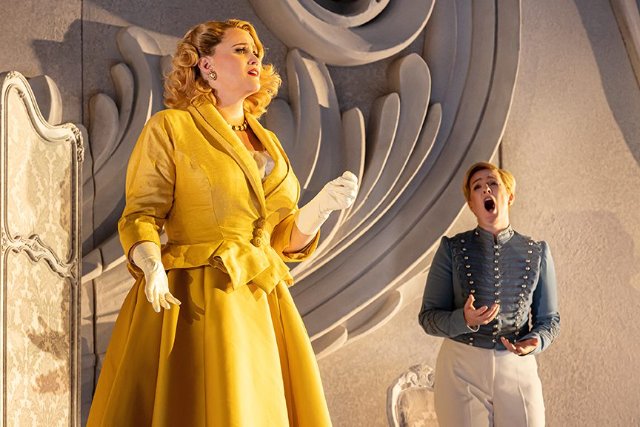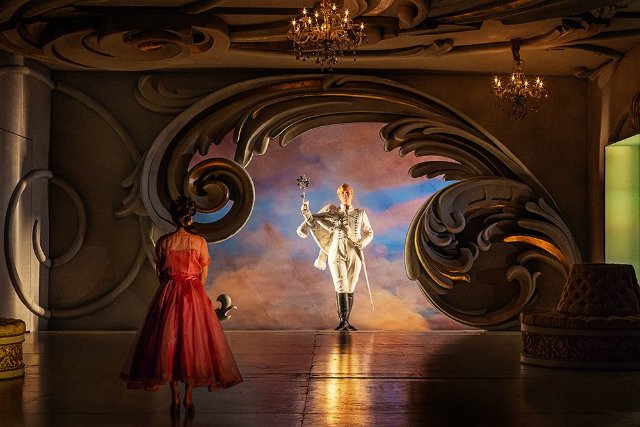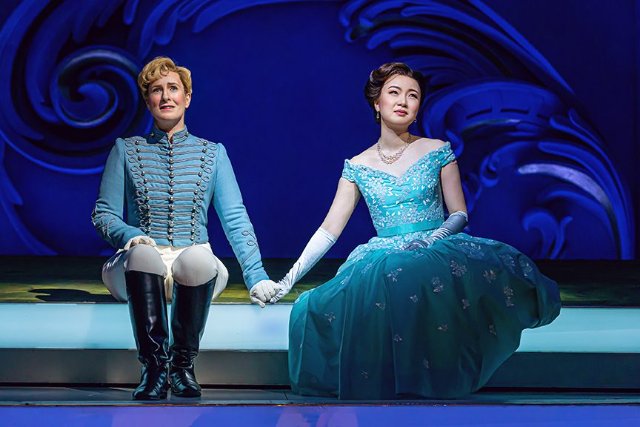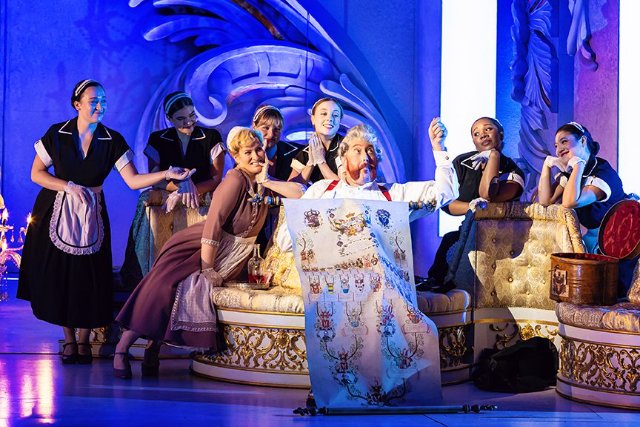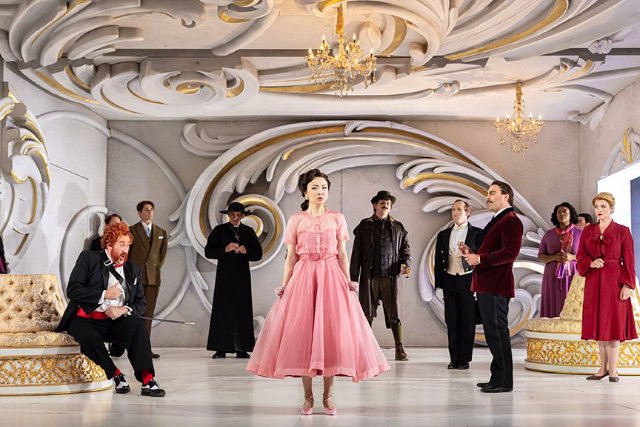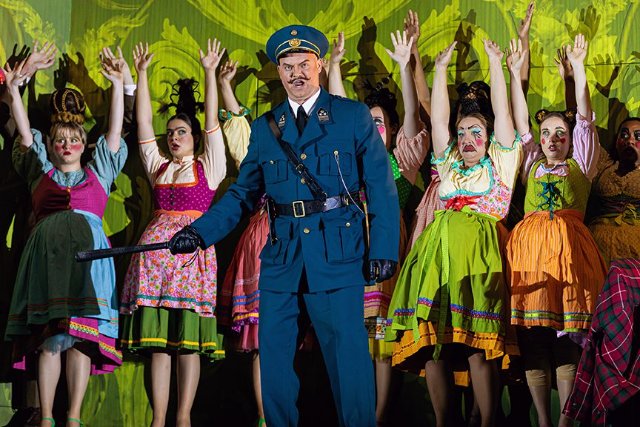Der Rosenkavalier
Santa Fe Opera's Delightful Strauss/von Hofmannsthal Comic Opera
By: Victor Cordell - Aug 17, 2024
Richard Strauss and Hugo von Hofmannsthal represent the most successful collaboration between composer and librettist in opera history. After drifting down the path of modern atonalism and gruesomeness with “Salome” and “Electra,” they risked being considered old-fashioned and retrograde with their 1912 premiere of “Der Rosenkavalier,” a return to German Romanticism, following in the footsteps of Richard Wagner. But it would become their most endearing opera with wonderful characterizations, sumptuous music, and a plotline that entertains and provokes. Santa Fe Opera has offered a superb production with outstanding performing artists and a stunning staging that warps from sumptuous to seedy.
The title refers to a fictional custom of Austrian nobility in which a prospective groom enlists a relative, who becomes the Cavalier of the Rose, to present a silver rose to the bride-to-be. This opera contains three central roles, one of which is the title character, who is a 17-year-old noble, Octavian, performed by Paula Murrihy. A versatile and smooth mezzo-soprano, she not only dispatches this notable trousers role with great aplomb but also wears dresses to become Mariandel, a fictitious maid who will deceive in order to trap lascivious Baron Ochs. The rationale for using a female voice in this role is that Octavian’s voice is presumed to be pre-pubescent. This woman-playing-a-man-playing-a-woman device beat the movie “Victor/Victoria” to the punch by several decades.
But while Octavian reigns in the title and perhaps has the most stage time and singing, the character acts more as a catalyst than a proactor. Perhaps the weight of the role is diluted because much of the time he is in his transvestite alter-ego, Mariandel. But in the end, Octavian will get the girl!
The anti-hero of the proceedings is the boisterous, bumptious Baron Ochs, portrayed delightfully and humorously by big-voiced bass Matthew Rose, who manages the semi-talk-sing requirements along with the resonant sung music with equal facility. Middle-aged Ochs had asked his cousin The Marschallin to arrange the presentation of the rose to young Sophie. This match appeals to both sides as the impoverished noble Ochs will acquire money from a nouveau riche family, while they gain aristocratic standing. But ultimately, Ochs’ condescending and off putting manner will infuriate the otherwise shy Sophie, who even risks being sent to a nunnery in rejecting the suitor.
With all of the above going on, it really hasn’t touched on the heart of the opera, and that is The Marschallin. Though she is absent for over half of the opera, her grace, dignity, consideration, and melancholy are the driving forces behind the action. In her, Strauss and von Hofmannsthal have crafted one of the most sympathetic characters in the canon and a fine part for a dramatic soprano. Rachel Willis-Sørensen ravishes with her physical presence and her full-bodied and lustrous voice with great penetration in the fortissimos.
“Der Rosenkavalier” concerns life’s passages. Ochs’ proposal represents not only transition to marriage, but one involving change in social status, financial transformation, and a May-December linkage. The Marschallin is married, but has had a long and loving relationship with Octavian, who is half her age – another May-December affair. She notes that time is strange – when we are young, we don’t think about it, though when we are older we think of nothing else. Sensing the future and displaying the wisdom of age, she frees Octavian to great dramatic effect and much against his wishes, which will facilitate the resulting of the right match.
This opera contains several distinctions. The orchestral music is radiant throughout, yet the vocals in its primary idiom are not in the least memorable. However, two particular set pieces are highly notable. The presentation of the rose contains simple but well-spaced harmonic orchestral notes that may come from a celeste and flute. They produce the most haunting and ethereal sounds imaginable, so that it would be heavenly, pretty much whatever’s being sung. This is also the magic moment when Octavian and Sophie’s eyes first meet and foretell the denouement.
Strauss loved the female voice. He challenges the singers with high tessitura, particularly Sophie, which Liv Redpath, performing this evening only, negotiates with ease. Few female ensembles can match the counter melodies and harmonies of the opera’s finale – led by the glorious trio among the three lead females and concluding with The Marschallin stepping away and leaving the final love duet to Octavian and Sophie. A last and unfavorable distinction is the length of the opera. At a four-hour run time, it does drag at times with excess philosophizing and could use some serious editing.
Nevertheless, the composer shows that he could write relatable and accessible melody. He disdained Italian opera and threw in an aria in that style as a parody, but it has appeal. He also included melodious waltzes which were intended to display the majesty of the period of the opera, even though they were an anachronism. And if you are tempted to think that Strauss was strait-laced, the lively music that opens the opera with The Marschallin and Octavian in a curtained, poster bed simulates sex, right up to its conclusion and afterglow!
Apart from fine singing and the animated orchestra conducted by Karina Canellakis, Santa Fe’s production by Bruno Ravella visually delights from start to finish. The Marschallin’s bedchamber of Act 1 comprises restrained gray stateliness with huge scrolled leaf motifs in thick bas relief. At the end of the act, she is spotlit during a soliloquy wearing a yellow gown that creates a strikingly beautiful duochorome with the backdrop. In Act 2, at the apartment of Sophie’s family, we see contrasting showiness of the merchant class. And the Act 3 look of a cathouse, where Ochs is being compromised, the gaudy set is akilter and surrounded by colored light frames presenting a great environment for the cacophony of garish costumes.
At this, the end of the season, I’d like to add another plug for Santa Fe Opera, and that is for its exquisite pre-opera talks. One option is the fantastic covered, outdoor buffets, though they have gotten to be quite expensive. A guest speaker with some connection to the opera of the evening always gives a talk to conclude the dinner. A predictably entertaining and informative option is the free talk given by long time lecturer Oliver Prezant. His talks always engage and give great insights, especially for those new to a particular opera, but even for those who are already familiar.
“Der Rosenkavalier,” composed by Richard Strauss with libretto by Hugo von Hofmannsthal and produced by Santa Fe Opera was performed at Santa Fe Opera House, 301 Opera Drive, Santa Fe, NM through August 15, 2024.

